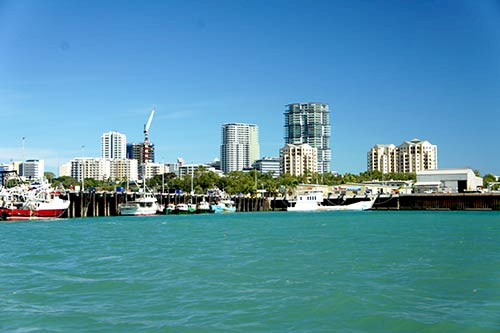Darwin: Captain Wickham, Harriet the Tortoise, Alaskan similarities, and Darwinian art
Bill Dennison ·The naming of the city of Darwin is an interesting case of premonition by a sailor. Port Darwin was named by Captain John Wickham in 1839 when the HMS Beagle sailed into Darwin Harbour as part of a survey of Australia's top end. Charles Darwin went on to become one of the most famous men in history, based on his theory of natural selection, the basis of evolutionary thought. However, when Port Darwin was named, Darwin had not published his famous book, "On the Origin of Species", published twenty years later (1859), or even his first scientific book, "The Structure and Distribution of Coral Reefs", published in 1842. John Wickham was a Lieutenant aboard the HMS Beagle with Captain Fitzroy when Darwin sailed as a naturalist before he became captain. Wickham and Darwin had become friends on the five year voyage and Wickham's naming of Port Darwin was more an acknowledgement of friendship than a tribute to a not-yet-famous man.

Another interesting aspect of the Darwin-Wickham friendship is that it resulted in a Galapagos tortoise named 'Harriet' to live in her long life in the Brisbane region. Charles Darwin collected three Galapagos tortoises during the Beagle's visit there in 1835. He gave the tortoises to Wickham who took them to Brisbane when he moved there in 1842. Wickham lived in Newstead House and was the Police Magistrate and Government Resident until Queensland gained statehood in 1859. Wickham Terrace, a street in Brisbane, was named after John Wickham. When Wickham left Australia, he donated Harriet and two other tortoises to the Brisbane Botanic Gardens. Harriet was originally named 'Harry', until it was determined that 'he was a she' in the 1960s. Harriet moved to Fleay's Fauna Sanctuary on the Gold Coast in 1952 and to the Sunshine Coast to what became Steve Irwin's Australia Zoo in 1987. I met Harriet at the Australia Zoo in 2001, where she was hand-fed hibiscus flowers and I was excited to meet a creature who had known Charles Darwin. Harriet died in 2006, at an estimated age of 175 years.

One observation about Darwin that I made is that there are some interesting similarities between the Northern Territory and Alaska (where I lived for several years), both in terms of people and extreme climates. Both regions have climatic extremes, with Alaska famous for its bitter cold temperatures and Northern Territory for its sweltering heat and humidity. In both Fairbanks, Alaska and Darwin, Northern Territory, you are adjacent to vast wilderness tracts on land and in the adjoining oceans. From Fairbanks or Darwin, you can drive out of town for a picnic lunch and if your car fails to start and you cannot easily summon help, you could die. The people who are attracted to the remote outposts tend to be a bit more free-spirited and see the role of government in a limited role. However, the federal governments of the United States and Australia provide significant infusion of money through various schemes to Alaska and Northern Territory. In both places there are large animals that can eat you (e.g., bears in Alaska and crocs in Darwin), although the perception is much worse than the reality in both cases. There are significant populations of indigenous peoples from a diversity of tribes/clans in both locations, with some living in traditional ways and some adopting Western ways. Both places were involved in World War II battles; Darwin being bombed by the Japanese and the Aleutian Islands being occupied by Japanese soldiers. In both cases, the reporting of these Japanese incursions was not shared with the general population at the time. The nearby international neighbors are another shared aspect. Darwin is actually closer to five capital cities of foreign governments than to the capital of Australia, Canberra, for example.
The city of Darwin is relatively modern, as it was bombed by the Japanese during World War II and was devastated by Cyclone Tracey, on Christmas 1974. This summer was a record wet one for Darwin, with nearly 3 meters (10 feet) of rainfall and the lush vegetation was testament to the rainfall.

As part of a North Australia Marine Research Alliance (NAMRA) workshop that I attended, Professor Andrew Campbell organized a tour of the Charles Darwin University Art Gallery, which was hosting an exhibit, "Mrs. Darwin's Garden". The artist, Carole Wilson, had produced various shapes like Victorian urns, leaves and birds that would appear in gardens. The shapes were colorful and arranged in an attractive manner, but what was particularly interesting was that, upon close inspection, the shapes were actually portions of maps. It was a remarkable exhibit with multiple layers of meaning, and the connection with the garden was the link with 'home' that gardening in far-flung locations provides. The translocation of Galapagos tortoises by Charles Darwin is an example of bringing the world into a Victorian home.
About the author
Bill Dennison

Dr. Bill Dennison is a Professor of Marine Science and Vice President for Science Application at the University of Maryland Center for Environmental Science.

